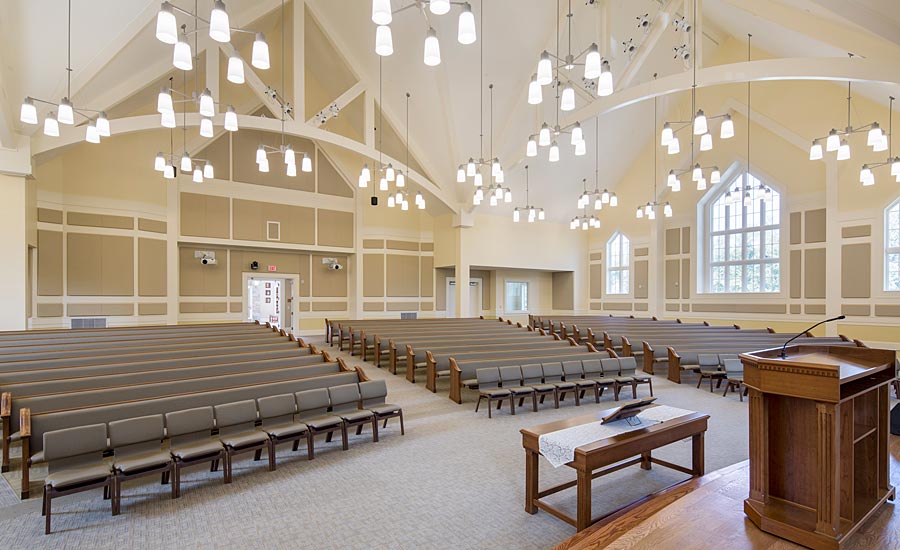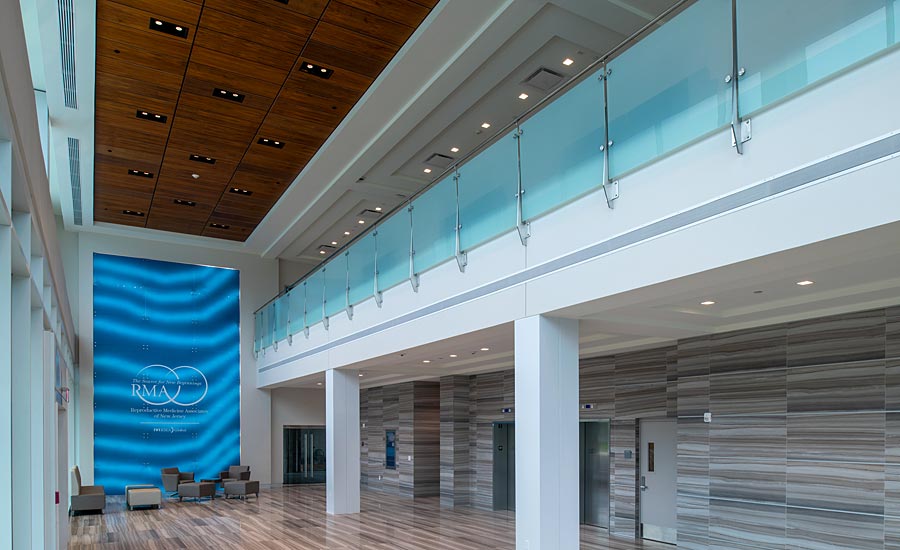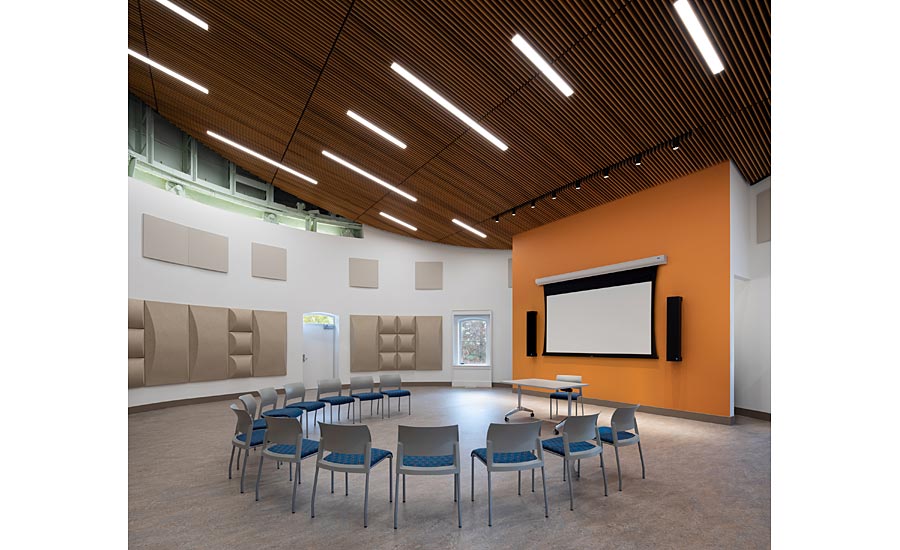In 1985, business partners Steve Welte and Bill Archacki founded Wallworks Inc. Its sole service was one thing: drywall. As the company began to grow, the construction industry began to change. Contractors were looking for carpentry contractors who were capable of installing steel studs, as well as other commercial carpentry services. The company grew by developing the skills and offering services to meet the needs of its customer base. Welte’s and Archacki’s ability to integrate the latest technology, establish best practices and remain committed to the carpentry craft has distinguished Wallworks as the leading full-service carpentry company in the region.
“Seeking to build responsibly and to understand the relationship that construction has to our environment, our employees are trained in building practices that help reduce the impact that our industry has to the environment,” says Vice President/General Manager Justin Henzel. “Many of our employees have successfully completed and have been awarded ‘Green Advantage Environmental Certification’.”
Manufacturers & Distributors
Many of the company’s projects have been LEED Certified or have incorporated sustainable building elements and green construction practices.
According to Henzel, the company understands that general contractors and construction managers depend on Wallworks to fulfill its promise to deliver a high quality project—on time and within budget. “As the largest trade on many of the projects in which we are involved, our performance impacts the success of a building project. This understanding is the foundation of how we do business and why our customers depend on us,” he says.
Wallworks is committed to building trust with all its construction partners. The heart of general contracting, according to Henzel, is the relationship between management and communication. The contractor understands and anticipates the needs of its customer—the GC, construction manager, owner or developer—along with the needs of the architect and engineer, and the needs of its subcontractors and field staff. This understanding and commitment is why Wallworks’ customers trust the company as a construction partner he says.
“We have built our reputation for more than 30 years by delivering high-quality, award-winning projects. In our business, details matter and delivering the design vision means understanding that the details are as important as the big picture,” says Henzel. “We believe in doing it right the first time, every time, and place value on diligent planning and stringent quality control. Our reputation for paying attention to the details tells our story that quality and craftsmanship matter—this is why our customers depend on us to deliver on the promise of a quality project every time.”
The company’s performance begins in the pre-construction stage, when the team of professional estimators develops high quality, accurate and complete cost estimates for our customers. The company has earned a reputation for developing solutions for complex projects with unique challenges and to developing a plan to successfully execute the work. This is why its customers depend on Wallworks to deliver on time and budget, says Henzel.
“As one of the largest full-service commercial carpentry companies in the Philadelphia region, we bring the financial, professional and man-power resources necessary to complete complex building programs,” he says. “When contractors need to get it done, they can depend on Wallworks.”
Wenzel says building the brand, reputation and process itself is the reward as the company’s greatest achievement.

Three Ways to Improve Manpower Productivity
As one of the largest trades on a project, carpentry can have a big impact on costs. Understanding the drivers of project costs—especially where these costs can overrun the budget is important. Wallworks Commercial Carpentry looks at three ways to improve job-site productivity and to control cost overruns, schedule delays and re-work:
- Using technology to enhance productivity
- Using top-down sequencing to eliminate work interference
- Engaging the Field Ops team to reduce the impact of rework
Use Technology
WallWorks understands that carpentry is one of the leading trades on a project and its level of accuracy sets the stage for a high-quality project, providing a cascading effect on quality. A simple error early in a project can have a compounding impact. Since walls are commonly dimensioned from previous measurements, a marking error on one wall layout, carried forward to the next, can compound the error over a distance. This error can have an impact on other trades if not corrected quickly. With laser technology, human calculations are not required and reading errors are reduced. This is especially valuable for complicated design elements such as circles, arcs, and complex soffits.
To ensure a high-quality start, Wallworks has invested in the most-advanced technology that expedites traditional manual layout processes such as leveling, aligning, plumbing and squaring.
Wallworks’ use of laser technology provides key competitive advantages to their customers—resulting from increased productivity and improved quality.
Speed: A laser-enabled process is faster than traditional layout methods;
Manpower: Ease of setup and one-person operation allows for efficient allocation of labor;
Cost-savings: Lasers dramatically reduce mistakes and the need for costly rework and downtime;
Scheduling: Enhanced trade coordination supports pull-planning and better scheduling, and;
Quality: Complicated shapes, arcs and curves are now easy to layout, reducing re-work.
“This technology has reduced the frequency of rework … for us and our customers there is a direct benefit in the cost of the mistakes you don’t make,” says Welte.

Using “Top-Down” Sequencing as a Best Practice to Eliminate Trade Interference
There is nothing more important to the construction productivity than how work is sequenced, scheduled and coordinated. For the carpentry trades, this is especially true—especially when it comes to “topping out” construction.
Top-down sequencing (aka “pre-rock,” “top-down” or “topping-out”) construction is recognized throughout the construction industry as a best practice that saves time and accelerates schedules. So, when this work is out-of-sequence it can have an enormous impact on productivity—negatively affecting schedules and costs.
Best practices call for primary corridor or interference walls to be installed before any of the MEP work such as HVAC ducts, main electrical conduits, plumbing, and fire suppression piping. Also, secondary or partition walls that are full height, extending to the underside of the structure, and are in conflict with MEP, should also be installed prior to MEP.
When this work gets out of sequence, and MEP work interferes with wall framing, drywall installation or finishing, it is especially harmful to the planned productivity of the carpentry trades.
“One way to solve coordination problems between MEP and drywall work is to identify priority walls that should be framed and topped down prior to installation of MEP work,” says Henzel. “This is critically important because this work can account for as much as 60 percent of the manpower on a project.”

On many projects, MEP contractors are made up of at least three separate subcontractors: a mechanical sub, an electrical sub and a plumbing sub. These separate subcontractors may even subcontract out certain parts of their work to other subcontractors. “We may be working with five or six different people from five or six different subcontracting firms, so this is where good coordination and good field operations comes into play” says Henzel.
“When it comes to determining priority-wall status each trade is going to have a different opinion. We recognize that some specialty contractors would like to go in first because their productivity decreases when they must work around drywall,” says Henzel. “This is where we rely on our field ops team to collaborate with other trades, ensure that our crews can be as productive as possible and eliminate as much re-work as possible.”
This type of collaboration and work structuring—not only within the carpentry trades but across the MEP and FP trades can have a major impact on production performance because of the interdependence of the trade work. Identifying and encouraging these coordination efforts will greatly improve the chance for a successful project. This not only saves construction time; it also ensures a better quality and compliant drywall installation.
Engaging the Field Ops Team to Reduce the Impact of Rework
Rework can consume up to 30 percent of the productivity on a project at a cost of 10 percent or more of the contract value. For the carpentry trades, the additional time needed to correct or redo finish work can spike labor costs by as much as 7 percent or more according to numerous industry productivity studies. Other industry studies placed the total cost of rework—including both the direct and indirect factors combined—at more than 9 percent of the total project cost.
The carpentry trades are heavily impacted on the job site. With so much at stake, Wallworks has developed a QA/QC focus that integrates the key members of their team:
- Training and continued development of craft skills;
- Project Management of cost and schedule;
- Field Operations and site coordination.
When the project manager, field operatives and craft workers are aligned, the work has the best chance to get done correctly the first time or to identify a problem if they see one and to resolve it quickly. This quick correction prevents the mistake from being duplicated throughout the construction.
“Because we maintain our own PM, field ops and craftsmen we have the advantage of a shared interest in our success. We know we succeed or fail together,” explains Welte.
But on a construction site, with multiple trades working towards completion, rework is often caused by other trades. Here is where a strong carpentry field operative’s team comes into play—ensuring coordination and communication between the carpentry and other trades. To reduce rework The Wallworks team looks for the following indicators of potential rework:
- Out of sequence activities or not well-planned activities. An example would be MEP trades who are under pressure to complete their work and create unplanned cuts in finished drywall.
- Changes that were not clearly communicated to all the trades. Design plans change, and often these changes affect work in progress, requiring rework. Here is where Field Ops has to watch the schedule carefully and move quickly to get ahead of the causes of rework as soon as possible.
- Wallworks trains its team to identify areas where rework often occurs and to craft a backup plan to adjust the schedule of work to minimize the effect it has on manpower and time.
By incorporating technology, best practices and collaboration on construction projects, teams can improve manpower efficiency to improve quality, reduce schedule delays and save costs. The use of new tech, good project management and strong field operations has become essential to success at Wallworks.
These practices underscore the principles of a partnering spirit and reinforce the contractor’s commitment to its customers and employees to bring strong craftsmanship, speed and innovation to every project and every customer.




